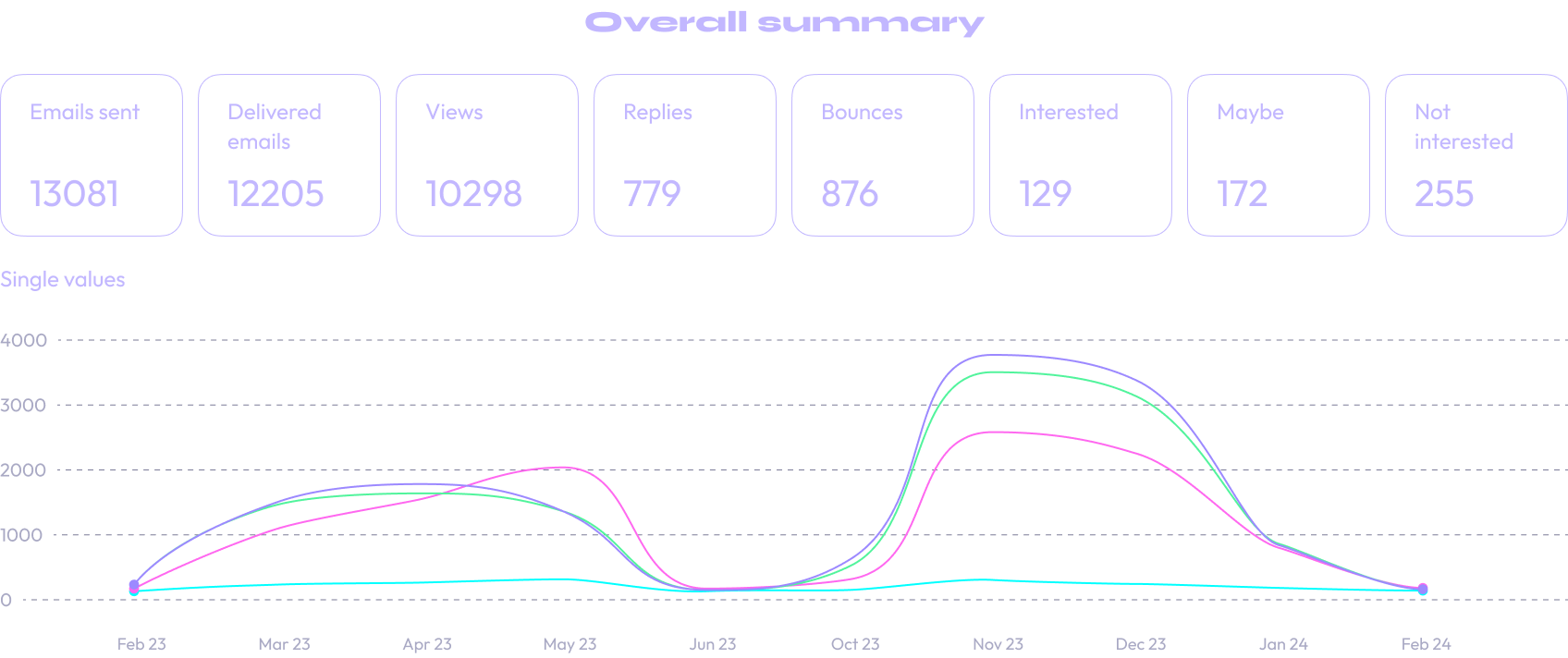Email Marketing for a Music Industry Client
Introduction
Client Overview: A music industry professional aiming to promote personal branding and upcoming concerts through email marketing.
Challenge: Previous outbound email marketing efforts were ineffective, resulting in low engagement and high spam rates.
Initial Diagnosis
DNS Records: Missing DKIM and DMARC setups led to emails being marked as spam.
IP & Domain Reputation: The IP reputation was damaged due to poor email practices.
Prospect Lists: Prospect lists were unorganized, with duplicates, invalid emails, and inconsistent formats.
Email Templates: No A/B testing, follow-ups, or CRM integration for tracking leads. Poorly personalized templates and broken links triggered spam filters.
Strategic Overhaul
Technical Fixes:
- Configured DKIM & DMARC records to improve deliverability.
- Cleaned up the IP reputation through gradual warm-up strategies.
Prospect List Management:
- Validated and standardized email lists.
- Removed duplicates and invalid emails.
Email Campaign Optimization:
- Implemented A/B testing for templates.
- Developed segmented and personalized templates.
- Set up follow-up sequences and integrated CRM for lead tracking.
- Ensured all links were functional and spam triggers were removed.
Best Campaigns After Strategic Overhaul
After implementing the strategic changes, several email campaigns stood out due to their high performance. Below are the details of these top campaigns:
Campaign 1:
- Target Audience: 160 recipients, likely a smaller, highly targeted group (e.g., high-value potential clients).
- Emails Sent: 160 emails sent.
- Open Rate: 51.6%
- Reply Rate: 17.5%

Engagement:
- Positive Response: 5 recipients.
- Neutral Response: 3 recipients.
- Negative Response: 11 recipients.

Key Features:
- Personalization based on previous interactions.
- A/B testing of subject lines to optimize open rates.
- Targeted follow-ups that increased reply rates.
Campaign 2:
- Target Audience: 642 recipients, focusing on a broader segment with an interest in premium offerings.
- Emails Sent: 642 emails sent.
- Open Rate: 75.2%
- Reply Rate: 30%

Engagement:
- Positive Response: 46 recipients.
- Neutral Response: 44 recipients.
- Negative Response: 64 recipients.

Key Features:
- High engagement through exclusive offers for early access to tickets.
- Follow-up emails personalized with recipient’s previous purchase history.
- Strong CTA (Call to Action) leading to a high reply rate.
Campaign 3:
- Target Audience: 993 recipients, aimed at a broad audience segment, possibly including newer subscribers.
- Emails Sent: 993 emails sent.
- Open Rate: 59%
- Reply Rate: 15.6%

Engagement:
- Positive Response: 35 recipients.
- Neutral Response: 41 recipients.
- Negative Response: 46 recipients.

Key Features:
- Targeted content based on recent subscriber activity.
- Incentives for early engagement (e.g., discounts, limited-time offers).
- Dynamic content blocks that increased relevance and interaction.
Performance Metrics

After implementing the strategic overhaul, the following metrics were recorded across all campaigns:
- Email Sent: 13,081 emails sent.
- Delivered: 12,205 emails delivered, achieving a 93% deliverability rate.
- Views: 10,298 views, indicating a significant engagement rate.
- Replies: 779 replies, leading to direct interaction with potential clients.
- Bounces: 876 bounces, reflecting a substantial improvement from the initial state.
- Number of Campaigns Created: A total of 20 campaigns were created during this period, each targeting different segments and objectives.
- Average Open Rate: Across all campaigns, the average open rate was 84.37%.
- Average Reply Rate: The average reply rate across these campaigns was 7.56%.

Interest Levels:
- Interested: 129 recipients showed clear interest.
- Maybe: 172 recipients indicated potential interest.
- Not Interested: 255 recipients, providing clarity on audience segmentation.

Analysis
The case study reflects the effectiveness of strategic technical adjustments combined with targeted content improvements.
The metrics show a clear progression from an ineffective campaign to one with higher engagement and improved deliverability.
Further segmentation and continuous optimization could enhance these results, particularly in converting “Maybe” responses to “Interested.”
Conclusion
Key Takeaways:
Technical foundation (DNS setup, IP reputation) is crucial for email marketing success.
Well-organized, validated prospect lists significantly reduce bounce rates and increase engagement.
Personalization and A/B testing in email templates can greatly enhance audience interaction.
The implemented strategy not only addressed the immediate issues but also established a sustainable email marketing framework for future campaigns.
At Leadige, we help businesses unlock the full potential of email marketing by creating high-converting campaigns that engage audiences and drive results. Whether you’re looking to improve your strategy, optimize deliverability, or scale your email outreach, we’re here to help.
Let’s elevate your email marketing efforts. Visit our contact page to explore how we can support your business growth.

